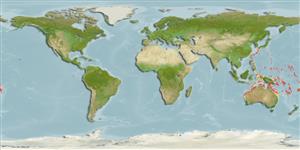>
Ophidiiformes (Cusk eels) >
Dinematichthyidae (Viviparous brotula)
Etymology: Alionematichthys: Name from Latin alius meaning the other or different, and nematichthys, the stem of the genus name Dinematichthys, to which this genus is most similar.; crassiceps: Named for the characteristic big head (Latin crassus for thick and the adjective ending derived from caput or head; noun in apposition..
More on authors: Møller & Schwarzhans.
Environment: milieu / climate zone / depth range / distribution range
Ecologia
marinhas associadas(os) a recifes; intervalo de profundidade 0 - 5 m (Ref. 90102). Tropical
Eastern Indian Ocean: Western Australia (Ref. 88966). Western Pacific: along oceanic islands, from Micronesia (Palau, Chuuk, Pohnpei, Kapingamarangi Atoll), Hermit I., and the Kiriwina (Trobriand) Is., New Guinea, Vanuatu, Fiji to Tonga. Probable records from Taiwan (NW Pacific).
Tamanho / Peso / Idade
Maturity: Lm ? range ? - ? cm
Max length : 6.3 cm SL macho/indeterminado; (Ref. 81230)
Descrição suscinta
Morfologia | Morfometria
Raios dorsais (total): 72-81; Raios anais : 57 - 64; Vértebras: 41 - 43. This species is distinguished by the following characters: ; D 72-81; A 57-64; small eyes (1.3-2.5%SL); blunt snout, no cirri; cheeks with scales and 3-10 scales above opercular spine; with upper preopercular pore; outer pseudoclasper broad-based, simple flap like, while the inner one with free, forward-pointing anterior lobe and broad posterior lobe; otolith length to height 1.9-2.0, with rounded dorsal rim; otolith length to sulcus length 1.7-1.8, very short caudal, ostium length to cauda length 4.5-5.0 (Ref. 81230).
Cryptic, solitary inhabitant of shallow water, usually in rocky crevices (Ref. 90102). A 5.6 cm SL gravid female (USNM 394976) with 95 embryos, 0.41 cm TL in length, and approximately 50 orange eggs, 0.06 cm in diameter (Ref. 81230).
Ciclo de vida ou comportamento de acasalamento
Maturidade | Reprodução | Desova | Ovos | Fecundidade | Larvas
Møller, P.R. and W. Schwarzhans, 2008. Review of the Dinematichthyini (Teleostei, Bythitidae) of the Indo-west Pacific, Part IV. Dinematichthys and two new genera with descriptions of nine new species. The Beagle 24:87-146. (Ref. 81230)
Status na Lista Vermelha da UICN (Ref. 130435)
Ameaça para os humanos
Harmless
Uso pelos humanos
Mais informação
Nomes comunsSinônimosMetabolismoPredadoresEcotoxicologiaReproduçãoMaturidadeDesovaAgregação de desovaFecundidadeOvosDesenvolvimento dos ovos
Idade/TamanhoCrescimentoPeso-comprimentoComprimento-comprimentoFrequências de comprimentoMorfometriaMorfologiaLarvasDinâmica larvalRecrutamentoAbundânciaBRUVS
ReferênciasAquaculturaPerfil para aquaculturaEstirpesGenéticaElectrophoresesHereditariedadeDoençasProcessamentoNutrientsConversão de massa
ColaboradoresFotosStamps, Coins Misc.SonsCiguateraVelocidadeTipo de nataçãoÁrea branquialOtólitosCérebrosVisão
Ferramentas
Relatórios especiais
Baixar XML
Fontes da internet
Estimates based on models
Preferred temperature (Ref.
123201): 24.4 - 29.3, mean 28.4 °C (based on 1383 cells).
Índice de diversidade filogenética (Ref.
82804): PD
50 = 0.5005 [Uniqueness, from 0.5 = low to 2.0 = high].
Bayesian length-weight: a=0.00389 (0.00180 - 0.00842), b=3.12 (2.94 - 3.30), in cm total length, based on all LWR estimates for this body shape (Ref.
93245).
Nível Trófico (Ref.
69278): 3.3 ±0.5 se; based on size and trophs of closest relatives
Fishing Vulnerability (Ref.
59153): Low vulnerability (10 of 100).
